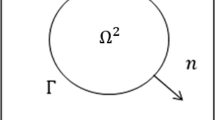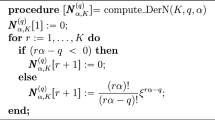Abstract
The ever-increasing robustness and reliability of flow-simulation methods have consolidated CFD as a major tool in virtually all branches of fluid mechanics. Traditionally, those methods have played a crucial role in the analysis of flow physics. In more recent years, though, the subject has broadened considerably, with the development of optimization and inverse design applications. Since then, the search for efficient ways to evaluate flow-sensitivity gradients has received the attention of numerous researchers. In this scenario, the adjoint method has emerged as, quite possibly, the most powerful tool for the job, which heightens the need for a clear understanding of its conceptual basis. Yet, some of its underlying aspects are still subject to debate in the literature, despite all the research that has been carried out on the method. Such is the case with the adjoint boundary and internal conditions, in particular. The present work aims to shed more light on that topic, with emphasis on the need for an internal shock condition. By following the path of previous authors, the quasi-1D Euler problem is used as a vehicle to explore those concepts. The results clearly indicate that the behavior of the adjoint solution through a shock wave ultimately depends upon the nature of the objective functional.
Similar content being viewed by others
References
Lions JL (1971) Optimal control of systems governed by partial differential equations. Number 170 in Die Grundelehren der mathematischen Wissenschaften. 1st edn. Springer–Verlag, Berlin
Mohammadi B, Pirroneau O (2001) Applied shape optimization for fluids. 1st edn. Oxford University Press, Oxford
Pirroneau O (1973) On optimal profiles in stokes flow. J Fluid Mech 59(1st edn): 117–128
Pirroneau O (1974) On optimal design in fluid dynamics. J Fluid Mech 64(1): 97–110
Jameson A (1988) Aerodynamic design via control theory. In: 12th IMACS world congress on scientific computation, MAE Report 1824, Paris, July 1988
Jameson A (1988) Aerodynamic design via control theory. J Sci Comput 3: 233–260
Jameson A (1995) Optimum aerodynamic design using cfd and control theory. In: AIAA 95-1729-CP, 1995
Kuruvila G, Taasan S, Salas MD (1994) Airfoil optimization by the one-shot method, optimum design methods in aerodynamics. AGARD-FDP-VKI Special Course, 1994
Taasan S, Kuruvila G, Salas MD (1992) Aerodynamic design and optimization in one shot. In: 30th Aerospace Sciences Meeting and Exhibit, Reno, NV, AIAA 92-0025, January 1992
Giles MB, Pierce NA (1998) On the properties of solutions of the adjoint Euler equations. In: Baines MJ (ed) Numerical methods for fluid dynamics VI, ICFD, June 1998
Giles MB, Pierce NA (2000) An introduction to the adjoint approach to design. Flow Turbul Control 65(3): 393–415
Angrand F (1983) Optimum design for potential flows. Int J Numer Methods Fluids 3: 265–282
Cabuk H, Sung C-H, Modi V (1991) Adjoint operator approach to shape design for incompressible flows. In: 3rd international conference on inverse design concepts and optimization in engineering sciences (ICIDES), College Park, PA, pp. 391–404
Cacuci DG, Weber CF, Oblow EM, Marable JH (1980) Sensitivity theory for general systems of non-linear equations. Nucl Sci Eng 75: 88–110
Marco N, Beux F (1993) Multilevel optimization: application to one-shot shape optimum design. Rapport de recherche No. 2068, INRIA, 1993
Beux F, Dervieux A (1993) A hierarchical approach for shape optimization. Rapport de recherche No. 1868, INRIA, 1993
Cusdin P, Mueller JD (2003) Automatic differentiation and sensitivity analysis methods for computational fluid dynamics. Internal Report QUB-SAE-03-old, Queen’s University Belfast, May 2003
Taylor AC III, Putko MM (2003) Some advanced concepts in discrete aerodynamic sensitivity analysis. AIAA J 41(7): 1224–1229
Hall MCG, Cacuci D (1983) Physical interpretation of the adjoint functions for sensitivity analysis of atmospheric models. J Atmos Sci 40: 2537–2546
Nadarajah SK (2003) The discrete adjoint approach to aerodynamic shape optimization. PhD thesis, Stanford University
Kim H, Nakahashi K (2005) Unstructured adjoint method for Navier-Stokes equations. JSME Int J 48(2): 202–207
Kim S, Alonso JJ, Jameson A (2004) Multi-element high-lift configuration design optimization using viscous continuous adjoint method. J Aircr 41(5):September–October
Kim HJ, Sasaki D, Obayashi S, Nakahashi K (2001) Aerodynamic optimization of supersonic transport wing using unstructured adjoint method. AIAA J 39(6): 1011–1020
Qiao Z, Qin X, Yang X (2002) Wing design by solving adjoint equations. In: 40th aerospace sciences meeting & exhibit, Reno, NV, January 2002. American Institute of Aeronautics and Astronautics, AIAA
Duta MC, Giles MB, Campobasso MS (2002) The harmonic adjoint approach to unsteady turbomachinery design. Int J Numer Methods Fluids 40: 323–332
Martins JRRA, Alonso JJ, Reuthers JJ (2005) A coupled-adjoint sensitivity analysis method for high-fidelity aero-structural design. Optim Eng 6: 33–62
Mani K, Mavriplis D (2008) Unsteady discrete adjoint formulation for two–dimensional flow problems with deforming meshes. AIAA J 46(6): 1351–1364
Nadarajah SK, Jameson A (2006) Optimum shape design for unsteady three-dimensional viscous flows using a non-linear frequency domain method. In: 24th applied aerodynamics conference, San Francisco, CA, June 2006. American Institute of Aeronautics and Astronautics, AIAA
Thomas JP, Hall KC, Dowell EH (2005) Discrete adjoint approach for modeling unsteady aerodynamic design sensitivities. AIAA J 43(9): 1931–1936
Giles MB, Pierce NA (1998) Superconvergent lift estimates through adjoint error analysis. http://citeseerx.ist.psu.edu/viewdoc/summary?doi:10.1.1.27.152
Giles MB, Pierce NA (1999) Adjoint recovery of superconvergent functionals from approximate solutions of partial differential equations. Report 98/18, Oxford University Computing Laboratory, Oxford, August 1999
Giles MB, Pierce NA (1999) Improved lift and drag estimates using adjoint Euler equations. AIAA Paper 99–3293, 1999
Giles MB, Pierce NA (2004) Adjoint and defect error bounding and correction for functional estimates. J Comput Phys 200: 769–794
Giles MB, Pierce NA, Siili E (2004) Progress in adjoint error correction for integral functionals. Comput Visual Sci 6: 113–121
Giles MB, Siili E (2002) Adjoint methods for pdes: a posteriori error analysis and postprocessing by duality. Acta Numerica 11: 145–236
Venditti DA, Darmofal DL (1999) A multilevel error estimation and grid adaptive strategy for improving the accuracy of integral outputs. AIAA Paper 99–3292, 1999.
Venditti DA, Darmofal DL (2000) Adjoint error estimation and grid adaptation for functional outputs: Application to quasi- one-dimensional flow. J Comput Phys 164: 204–227
Venditti DA, Darmofal DL (2003) Anisotropic grid adaptation for functional outputs: application to two-dimensional viscous flows. J Comput Phys 187: 22–46
Giles MB, Pierce NA (2001) Analytic adjoint solutions for the quasi-1D Euler equations. J Fluid Mech 426: 327–345
Nadarajah SK, Jameson A (2000) A comparison of the continuous and discrete adjoint approach to automatic aerodynamic optimization. In: 38th AIAA aerospace sciences meeting and exhibit, Reno, NV, AIAA–2000–667, January 10–13, 2000
Giles MB, Ghate D, Duta MC (2005) Using automatic differentiation for adjoint cfd code development. Post SAROD Workshop, 2005. Bangalore, India
Mueller JD, Cusdin P (2005) On the performance of discrete adjoint cfd codes using automatic differentiation. Int J Numer Methods Fluids 47: 939–945
Mavriplis DJ (2006) Multigrid solution of the discrete adjoint for optimization problems on unstructured meshes. AIAA J 44(1): 42–50
Nadarajah SK, Jameson A (2001) Studies of the continuous and discrete adjoint approaches to viscous automatic aerodynamic shape optimization. In: Computational fluid dynamics conference, Anaheim, CA, AIAA–2001–2530, June 2001
Giles MB, Pierce NA (2000) Analytic adjoint solutions for the quasi-1D Euler equations. Report 00103, Oxford University Computing Laboratory, Oxford, March 2000
Venditti DA, Darmofal DL (2002) Grid adaptation for functional outputs: application to two-dimensional inviscid flows. J Comput Phys 176: 40–69
Xie L (2002) Gradient-based optimum aerodynamic design using adjoint methods. PhD thesis, Virginia Polytechnic Institute and State University
Hirsch C (1994) Numerical computation of internal and external flows, vol I of Wiley series in numerical methods in engineering, 1st edn. Fundamentals of Numerical Discretization. Wiley, NY
Hirsch C (1994) Numerical computation of internal and external flows, vol II of Wiley series in numerical methods in engineering, 1st edn. Computational methods for inviscid and viscous flows. Wiley, NY
Lax PD (1973) Hyperbolic systems of conservation laws and the mathematical theory of shock waves 1st edn. Society for Industrial and Applied Mathematics–SIAM, Philadelphia, PA
Leveque RJ (2002) Finite volume methods for hyperbolic systems. 1st edn. Cambridge University Press, Cambridge texts in applied mathematics.
Giles MB, Pierce NA (1997) Adjoint equations in cfd: duality, boundary conditions and solution behavior. AIAA Paper 97–1850, 1997
Pulliam TH (1986) Artificial dissipation models for the euler equations. AIAA J 24(12): 1931–1940
Vanderplaats GN (1984) Numerical optimization techniques for engineering design: with applications. Series in mechanical engineering, 1st edn. McGraw-Hill
Author information
Authors and Affiliations
Corresponding author
Rights and permissions
About this article
Cite this article
Volpe, E.V., de Castro Santos, L.C. Boundary and internal conditions for adjoint fluid-flow problems. J Eng Math 65, 1–24 (2009). https://doi.org/10.1007/s10665-008-9258-7
Received:
Accepted:
Published:
Issue Date:
DOI: https://doi.org/10.1007/s10665-008-9258-7




